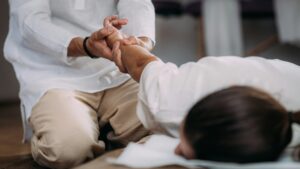Mobility

Mobility
Mobility, in the context of physical well-being, refers to the ability to move your body freely and effortlessly. It encompasses both flexibility (the range of motion in your joints) and strength throughout that range of motion. Focusing on mobility training offers numerous benefits for overall health, fitness, and quality of life, promoting functional movement and physical longevity.
What is Mobility Training?
Mobility encompasses several key components essential for optimal physical function:
- Joint Range of Motion: Mobility involves the full range of movement potential in a particular joint. Sufficient range of motion is crucial for everyday activities and athletic performance.
- Flexibility: Flexibility refers to the ability of your muscles and connective tissues to lengthen and stretch, impacting your range of motion.
- Strength and Control: True mobility is not just about passive flexibility. It emphasizes active control and strength throughout your entire range of motion.
- Movement Coordination: Mobility involves neurological coordination and the ability to move your body in fluid, efficient patterns.
How Can Mobility Training Help You?
Prioritizing mobility training offers a wide array of benefits spanning both immediate and long-term physical well-being:
- Reduced Pain and Stiffness: Mobility exercises help to increase flexibility, improve joint function, and alleviate muscle tightness, reducing pain and stiffness throughout the body.
- Improved Posture: Mobility work corrects muscle imbalances and faulty movement patterns, promoting improved posture and reducing associated aches and pains.
- Injury Prevention: Enhancing mobility increases your resilience against injuries by improving joint stability, range of motion, and the ability to handle physical stress safely.
- Enhanced Athletic Performance: Good mobility translates to greater power, speed, agility, and overall athletic performance.
What is Mobility Training Good For?
Mobility training finds applications across diverse areas, benefiting individuals seeking improvement in various ways:
- Daily Life Activities: Good mobility underlies your ability to perform daily functional movements like bending, squatting, reaching, and carrying with ease and comfort.
- Sports and Fitness: Mobility training enhances athletes’ performance, reduces injury risk, and aids in faster recovery for training longevity.
- Pain Management: Mobility exercises are valuable for chronic pain management, particularly for conditions like arthritis and lower back pain.
- Posture Correction Mobility work helps address postural imbalances due to sedentary lifestyles, prolonged sitting, and repetitive movement patterns.
- Rehabilitation: Mobility training is incorporated into post-injury and post-surgery rehabilitation plans for regaining function and range of motion.
Benefits of Mobility Training
Embracing mobility training unlocks numerous advantages impacting your physical function and overall well-being:
- Increased Range of Motion: Develop greater flexibility and movement potential in your joints through mobility exercises.
- Improved Strength and Stability: Mobility emphasizes control throughout your range of motion, improving overall musculoskeletal strength and joint stability.
- Reduced Injury Risk: Enhance your resilience against injuries by improving joint, muscle, and tendon health and increasing your body’s adaptability.
- Pain Reduction: Experience reduced pain and stiffness through increased flexibility, improved posture, and release of muscle tension.
- Better Performance and Recovery: Enjoy greater performance, power, and efficiency of movement in sports and daily activities alongside faster recovery.
What to Expect from Mobility Training with a Practitioner
Mobility assessments and training sessions may vary depending on the practitioner’s approach:
- Assessment: Your practitioner will likely assess your baseline mobility, including joint range of motion, flexibility, movement patterns, and any specific limitations.
- Personalized Plan: Based on the assessment, a plan is created using specific mobility exercises, stretching techniques, and bodywork approaches.
- Mobility Drills and Exercises: You will be guided through dynamic and static stretches, joint mobilizations, and targeted movements to improve various joints and muscle groups.
- Modifications and Progressions: The plan is adapted to your fitness level and goals. As you progress, exercises and intensity may be tailored.
- Home Practice: Practitioners often provide resources and instructions for home-based mobility exercises to enhance daily practice.
Similar Modalities to Mobility
Other modalities share similarities with mobility training, focusing on flexibility, range of motion, and overall movement optimization:
- Yoga: Many yoga postures and sequences incorporate elements of mobility work, improving flexibility, range of motion, and movement coordination.
- Pilates: Pilates emphasizes core stability and controlled movements throughout a full range of motion, often enhancing mobility as a secondary benefit.
- Physical Therapy: Physical therapists utilize mobility-focused movements, stretches, and techniques as part of injury rehabilitation and pain management.
Final Thoughts
Mobility is an essential component of overall physical well-being and a key to healthy aging. Whether seeking better performance or simply desiring pain-free living, investing in mobility training offers transformative benefits, granting you a more capable, resilient, and adaptable body.
Scientific References
- Alter, M. J. (1996). Science of flexibility (3rd ed.). Champaign, IL: Human Kinetics. (Provides a comprehensive scientific overview of flexibility and its impact on physical function)
- Macrum, E., Bell, D. R., Boling, M., Leunig, M., & Ganz, R. (2012). Effect of limiting hip range of motion on functional deficits in patients with femoroacetabular impingement. Clinical Orthopaedics and Related Research, 470(6), 1431-1440.(Investigates the relationship between limited hip mobility and functional impairments in individuals with a specific hip condition)
- Page, P. (2012). Current concepts in muscle stretching for exercise and rehabilitation. International Journal of Sports Physical Therapy, 7(1), 109–119. (Reviews the science of muscle stretching and its applications in exercise and rehabilitation settings)
Recommended Reading
- Becoming aSupple Leopard: The Ultimate Guide to Resolving Pain, Preventing Injury, and Optimizing Athletic Performance by Kelly Starrett (A popular guide to improving mobility, flexibility, and movement patterns for performance and injury prevention)
- Movement Matters: Essays on Movement Science, Movement Ecology, and the Nature of Movement by Katy Bowman (Explores the importance of natural movement and its impact on physical and mental well-being)
- Deskbound: Standing Up to a Sitting World by Kelly Starrett (Addresses the negative impact of sedentary lifestyles and provides strategies for incorporating more natural movement throughout the day).
FAQ: Mobility
How often should I do mobility training?
Ideally, incorporate mobility exercises into your routine several times a week. Even short, dedicated sessions can significantly impact your mobility.
Is mobility training the same as stretching?
While stretching plays a role, mobility training encompasses a broader approach, including dynamic movements, joint mobilizations, and strength throughout your range of motion.
Can mobility training help with chronic pain?
Yes! Mobility training can be beneficial for chronic pain management by improving posture, joint function, and releasing muscle tightness. Consult a healthcare professional for a personalized plan.
I'm not flexible at all. Can I still benefit from mobility training?
Absolutely! Mobility training meets you at your current level and offers progressions to gradually improve your flexibility and range of motion.
How long does it take to see results from mobility training?
With consistent practice, you may start noticing improvements within a few weeks. However, significant shifts in mobility typically require ongoing dedication to a training program.
Related Practitioners
Rita Mustafa
Healing Beyond Boundaries: Personalized Holistic Wellness for You and Your Pets
- City Centre, Windsor, ON, Canada
- +1 (678) 210-5270
Rita’s years experience in the health and Fitness, coupled with her educational background and ongoing activities, have inspired her to… Read More
Helena Fleming B.A., M.A. LIC I.S.H, RHOM
HOMEOPATHY & BIORESONANCE
- 3 Meadowbrook, Tulsk, Co. Roscommon, F45 FH97, Ireland
- (678) 210-5270
I am a homeopath and bioresonance practitioner with 27 years experience. I combine a classical approach to homeopathy with state-of-the-art… Read More















